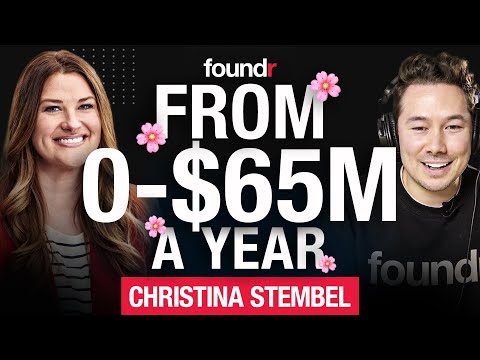Women founders face additional challenges when starting their businesses–from securing less funding than their male counterparts to dealing with prejudice in the boardroom. It can be tough and it can be discouraging.
This is exactly why we’re celebrating International Women’s Day with a healthy dose of inspiration from female founders who have been there and done the dang thing. When you’re in the mud struggling to stretch your last dollar or bootstrap as you scale, it can be helpful to point to the women who have come before you and encountered the same struggles, only to make it to the other side.
Here are 5 female entrepreneurs who have bootstrapped and worked their way to massive success.
Tiffany Masterson, Drunk Elephant
Like a lot of stay-at-home moms, Tiffany Masterson wanted to find a way to make a little extra money. In addition to raising 4 kids, she started selling bar cleansers. That side hustle soon turned into a passion for skincare, leading Masterson to create Drunk Elephant, a skincare behemoth that was acquired for a staggering $845 million.
Research was the cornerstone of Masterson’s approach. It was investigating the biology of skin that pushed Masterson to create her own skincare philosophy, and she maintained a strong focus on collecting data while she built the brand.
“I also did a lot of reading and researching around, what do we need in our daily routine? What do people basically need?” Masterson says. “And what I came up with was a low pH balanced cleanser, moisturizing oil or moisturizer loaded with antioxidants, a vitamin C serum, a glycolic or a chemically exfoliating serum, which is my TLC serum, a physical sunblock, as opposed to a chemical sunscreen. And that’s what I launched with.”
By distilling what the research had shown and creating a tight product line, Masterson started a brand that was equally comprehensive and minimalist. She explained, “I launched with kind of everything you need and nothing you don’t.”
Christina Stembel, Farmgirl Flowers
Christina Stembel, founder of Farmgirl Flowers, started her multi-million dollar brand by emptying her savings and giving herself a deadline. She told us, “I had $49,000 of savings. I was like, ‘I’m going to start this with $49,000. I gave myself 2 years or until I ran out of money.’” But that wasn’t just the money Stembel had for the business, that included her living expenses, too. She entirely bootstrapped her way to success.
“Everything was very bare-bones, very grassroots,” she says.
“It cost about 5,000 to start the website. I had to go teach myself how to make flower arrangements. I knew nothing about flowers. So I would go buy flowers and practice and watch YouTube videos and how to process flowers or anything like that. Just did everything myself. I did it from my dining room for the first 2 years.”

Heidi Zak, Thirdlove
Thirdlove has grown to one of the leading names in women’s underwear, but this major player also started as a small, bootstrapped ecommerce company in silicon valley. Before she started Thirdlove, Zak had a promising job at Google– the modern epitome of prestige and stability. Zak decided to bet on herself and quit to launch Thirdlove.
Zak remembers Thirdlove’s breakthrough coming when they rolled out their Try Before You Buy program. Before that, times were tough. “There were days in the early days of ThirdLove where we would get no orders,” she said. A lot of traditional marketing didn’t work as well for Zak in the beginning.
Throughout the struggle, Zak maintained a testing mindset, even with her products. “We had a lot of different bra styles in the early days, and there was this one bra style that ended up working that’s still our number one product, it’s our hero product called the 24/7 T-shirt bra.”
Zak describes the process that led to their success as “trial and error.” Once they found what worked, the rest fell into place. “When you have a hero product and you have the right marketing message, then everything becomes easy. It’s like magic, right?”
Alexa von Tobel, LearnVest and Inspired Capital
Many of us have struggled with personal finance, and Alexa von Tobel is no exception. But what makes von Tobel different is that she went on to found a $200 million investment fund. Von Tobel sees money as the basic lifeline that everyone needs to thrive.
“If you’re living for tomorrow, you can’t think long term,” von Tobel explained. But on the other hand, she says, “If you can create financial stability for a family, you can help a family thrive.”
Through LearnVest, von Tobel taught others how to grow their savings account and create solid rules around their personal financial practices. From there, she was able to launch Inspired Capital, a fund that offers early-stage investment to entrepreneurs.

Katia Beauchamp, Birchbox
When Katia Beauchamp learned that pretty much nobody was buying beauty products online, she jumped to action. She and her cofounder, Hayley Barna, started Birchbox in 2010 to take the fear and uncertainty out of buying beauty products online. Birchbox provided a monthly subscription box filled with beauty samples and allowed customers to buy the full-size versions of any of the products they liked.
While the brand has since grown to a 9-figure business, Beauchamp faced her fair share of struggles. “Everyone told us at the start that Birchbox was a dumb idea,” Beauchamp says.
“We were like, ‘Well, we’re 27-year-old smart women and we feel we would pay for this.’ Everyone’s response was no one will pay for this because sampling was seen as a free gift. And consumers were used to getting it for free. And we thought, well we’re not stupid. We would pay for this.”
And you know what happened next? Birchbox blew up.
Watch our full interview with Katia.
The post 5 Female Founders Showing Us How It’s Done appeared first on Foundr.
Source :- https://foundr.com Author :- Mary Kate Miller Date :-March 02, 2022 at 09:07PM